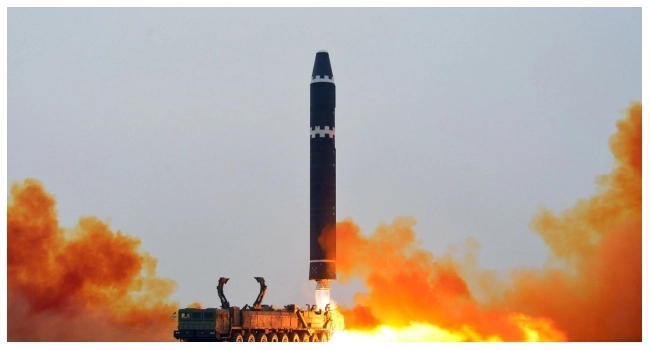North Korea said Sunday it had test-fired an intercontinental ballistic missile as a warning to Washington and Seoul, saying the successful “surprise” drill demonstrated Pyongyang’s capacity to launch a “fatal nuclear counterattack”.
In response, the US and South Korea staged joint air drills featuring a strategic bomber and stealth fighter jets, Seoul said.
North Korean leader Kim Jong Un ordered the “sudden launching drill” at 8:00 am Saturday (2300 GMT Friday) and a Hwasong-15 missile — a weapon first tested by the North in 2017 — was fired from Pyongyang airport that afternoon, the official KCNA reported.
South Korea’s military said it detected an ICBM launch at 17:22 (0822 GMT) Saturday, which Japan said flew for 66 minutes before splashing down in its Exclusive Economic Zone, with their analysis indicating it was capable of hitting the mainland United States.
North Korea’s leadership hailed the test — the country’s first in seven weeks — saying it showed “the actual war capacity of the ICBM units which are ready for mobile and mighty counterattack”, KCNA said.
The launch was “actual proof” of the country’s “capacity of fatal nuclear counterattack on the hostile forces”, it added.
The South Korean military said Sunday it had staged joint air drills with the United States featuring at least one US B-1B long-range bomber.
“The exercise displayed the timely and immediate deployment of the US extended deterrence assets to the Korean peninsula,” demonstrating the “overwhelming force” of the allies, the ministry said in a statement.
The sanctions-busting North Korean launch came just days before Seoul and Washington are due to start joint tabletop exercises aimed at improving their response in the event of a North Korean nuclear attack.
Pyongyang had last week warned of an “unprecedentedly” strong response to upcoming drills, which it describes as preparations for war and blames for the deteriorating security situation on the Korean peninsula.
New milestone?
The Saturday test is significant as “the event was ordered the day-of and so this is not so much a traditional ‘test’, but an exercise,” US-based analyst Ankit Panda told AFP.
“We should expect to see additional exercises of this sort,” he added.
The exercise appeared to be “Kim’s way of telling the US and ROK that his country is continuing to hone its ballistic missile capabilities for eventual use in a real-time scenario”, said Soo Kim, a former CIA Korea analyst who now works at management consulting firm LMI.
“The weapons aren’t for display only,” she told AFP. “This layer of imminence is probably intended to intimidate the allies, notably as they’re making efforts to strengthen deterrence in the Korean Peninsula.”
Park Won-gon, a professor at Ewha University, said it marked the first time that North Korea had given a detailed account of the order-to-launch process.
“The clear indication of Kim Jong Un’s order is significant,” Park said. “The Sunday test shows that these weapons are all deployed for actual combat and ready to launch at any time.”
But the nine-hour process from Kim Jong Un’s order to the actual launch was “a long time”, Soo Kim said, suggesting Pyongyang may face “greater challenges in launching in a realistic scenario”.
Relations between the two Koreas are already at one of their lowest points in years, after North Korea declared itself an “irreversible” nuclear state and leader Kim called for an “exponential” increase in weapons production, including tactical nukes.
In response, South Korea’s President Yoon Suk Yeol has sought to boost cooperation with the US, pledging to expand joint military exercises and improve Washington’s so-called extended deterrence offering, including with nuclear assets.
On Sunday, North Korea spokeswoman and Kim’s sister Kim Yo Jong claimed it was these moves by Seoul and Washington that “further endangers the situation every moment, destroying the stability of the region”, according to a KCNA report.
“I warn that we will watch every movement of the enemy and take corresponding and very powerful and overwhelming counteraction against its every move hostile to us,” she added.
Food shortages?
All of this points to “the start of high-intensity provocations from North Korea”, Professor Park of Ewha University told AFP.
“What’s different from 2022 is that last year their justification was that the launches were part of their five-year military plan,” he said.
“Now they are making clear that they will counter the United States and South Korea.”
Park said the redoubled aggression from Pyongyang could also indicate the domestic situation had worsened. South Korean officials recently warned the country could be facing severe food shortages after years of pandemic-linked isolation.
“North Korea always takes a hardline approach and creates external crisis as part of its ‘siege mentality’ tactic to overcome internal struggles. It is a typical North Korean behaviour to unite the people by highlighting the South Korea-US threat.”

